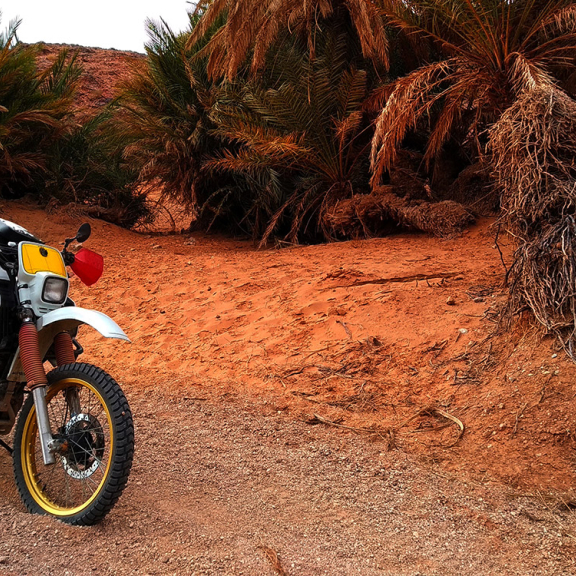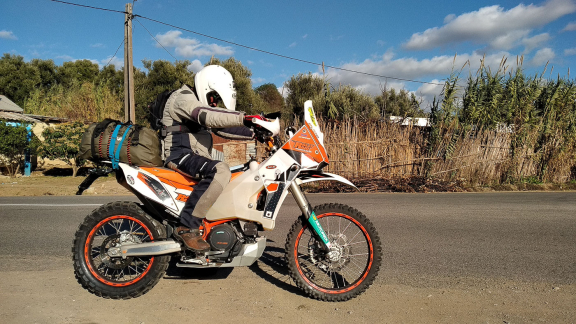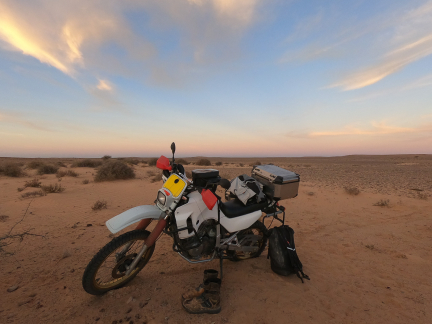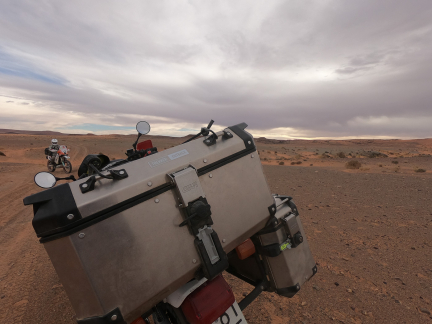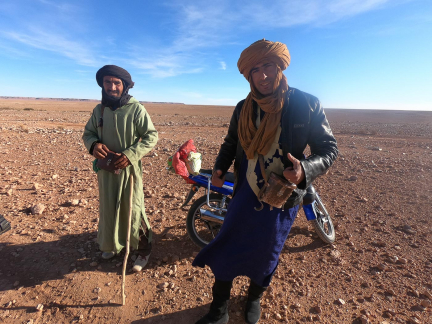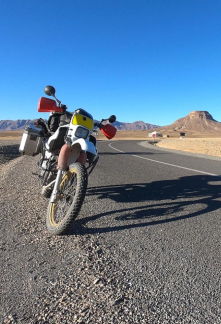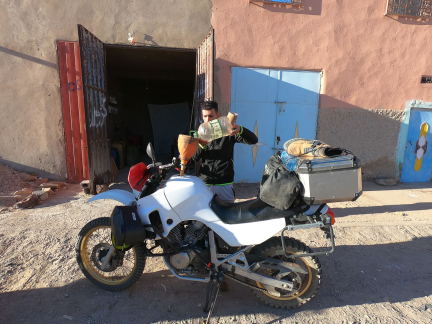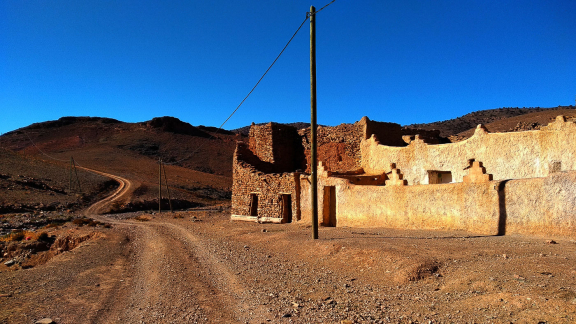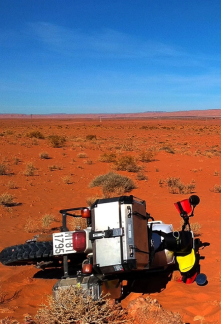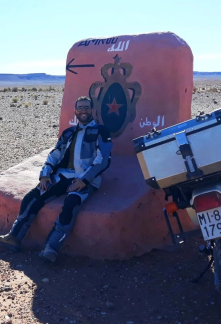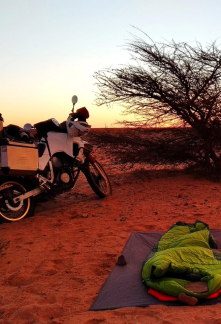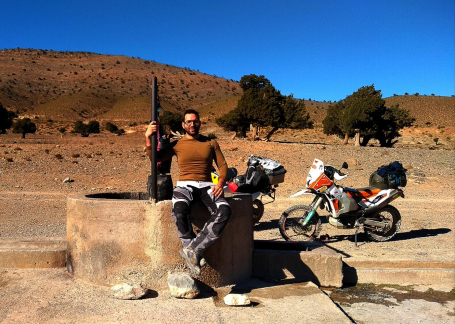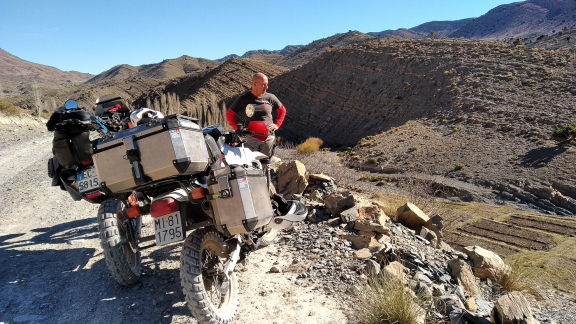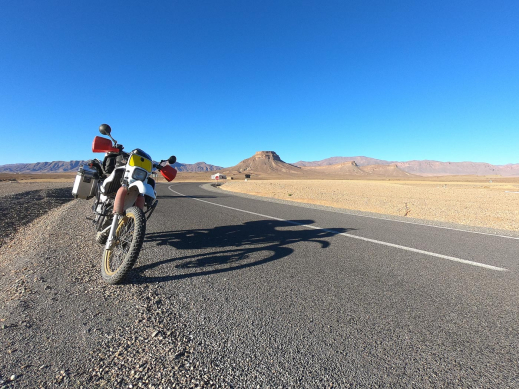Africa: Rolling South from Morocco As Far As Mali
Travelling to Timbuktu, in Mali, from the north of Morocco
Imagine simply rolling, well, that’s the best way to sum up the start of this adventurous trip.
After years of extreme travel by bicycle, a bad back and an inability to count solely on my own strength as I discovered the world both within and around me, saw me add an engine to my wheels in the spring of 2019..
A 30-year old 600cc Japanese twin with 50 HP seemed to me to be the most interesting solution.
Having found a 1993 Honda Transalp locally, I decided to get it modified and make it as ‘desert-friendly’ as possible for a trip that had been buzzing around my head like a crazed fly for years. Travelling to Timbuktu, in Mali, from the north of Morocco, across the challenging and hostile Western Sahara, down through the unexplored and little known Mauritania all the way to the most interesting country in the Sahel – Mali. The name pre-empts the charm of fairy-tale places where you can always count on marauders in the desert, improbable characters and mysterious stories.
After misunderstandings and arguments with a mad mechanic, I set off on 9 December, two months later than planned. The climate, conditions and terms had all changed in the meantime, but my idea definitely hadn’t. I was keener than ever to reach Mali. It was manna from heaven to have fundamental support from GIVI, all thanks to Matteo, an old friend, and the very professional Mario, who liked my idea. They were so very helpful and I received everything I needed in record time and in an impeccable fashion.
After a cold morning spent travelling to the port of Genoa, I boarded the ferry for Tangier in the dead of night. The endless line of Moroccan citizens with their overloaded cars, all heading home for the winter to see their families, immediately gave me the sensation of crossing not just a sea, but another continent.
Africa. On the cold jetty and with my bike loaded like a mule in the Far West, I met someone who, throughout the trip, would prove to be an adventure companion and an off-road riding master – Alberto, sixty plus with a body of steel, and his formidable KTM 690 with extreme Rally Raid kit, an icon from the start.
Libya, Niger, Tunisia, Mauritania and dozens of trips to Morocco, a veteran who embodied the pure spirit of the 80s-90s Dakar. And it was he who quickly taught me all that I now know about surviving off-road bike trips, from calculating distances to extracting myself from the terrible Saharan sands with a 250 kg bike.
We immediately felt like kindred spirits, me wanting to reach Mali and him keen to escape the December temperatures of Genoa. I had never been keen on sharing certain types of adventure, everyone has their own pace and different priorities, but there are some characters who you should keep close when you meet them, or perhaps it was just God helping me out in some way?
On reaching the port of Tangier, Alberto and I rushed to escape the boat. While sorting our documents at the port, we met a couple of Slovenian riders in their seventies (proof that there is no age limit to adventuring) who shared our journey for a few days before we went our separate ways.Alberto had almost all the roads worth travelling mapped out with surgically-precise GPS traces. Immediately avoiding the big modern cities, some on a par with the European capitals in terms of their evolution and development, we decided to stick to the more rural, genuine, and less frequented areas of this wonderful and indecipherable country, remembering that at five each afternoon night would envelope us.Over just a few miles, the landscape went from the greenest, cold peaks to flat, arid expanses, then coast, cultivated fields and rocky mountains. It was incredible how, over such a short distance, this part of Africa could change so quickly. There was little traffic, the roads were perfect, with just a few main routes and millions of web-like back streets. The names of towns were lost over the miles, Fez, Chefchaouen, Ifrane, Erfoud, Boudnib, Ouarzazate, I remember them for a few moments, my gaze taking in the faces of the people in those places.
The curiosity and smiles of the children, the diffidence and national dignity of the adults. And you can’t blame them… Morocco, a country conquered by the French, the Spaniards and not yet totally free from the sense of European invasion. At every turn, the kids would signal us to speed up or wheelie with our spacecraft. With my Hevik Titanium R suit, I really felt like a spaceman – hot, cold, wind and rain, it protected me from everything.
For many days, my thermal suit didn’t smell and perfectly maintained my temperature without making me sweat. In the worst conditions, I also had a waterproof suit to keep me dry.
What were once leather and canvas bags waxed with animal fat to protect against bad weather have now found a worthy replacement with the watertight GIVI Trekker Outback cases. The solid aluminium stood up to the very worst crashes during my trip. (Every day, on all terrains. Not a single dent). The very robust rapid-release attachments allowed me to carry them around like bags, but with the security of a safe, protecting all my photo and video equipment and sacred documents like my passport and bike registration certificate. The combination of sand, salt and rain is more corrosive than petrol.
After a few days on the asphalt as far as Boudnib, where the famous Dakar tracks begin, Alberto and I were the only ones to stop at the inns in the small towns as we sought out low prices. All we wanted to do was close our eyes after a day in the saddle and we’d collapse as soon our heads hit the pillow, sleeping until morning. The days passed with a hypnotic rhythm. The routine of getting dressed and undressed, loading and unloading the bike, stopping to eat street food in apocalyptic shacks in the middle of isolated villages that were nothing more than a handful of houses, in areas where time appeared to stand still.
Life passes slowly in those places, our two bikes the only thing to break the silence.
The Dakar Tracks alternated between deep sand and gravel for hundreds of miles and without any landmarks, at most a rock indicating the direction.
Without GPS, we would have had no hope of finding our way, not like the shepherds and nomads who were able to cross the dunes effortlessly with their scooters, leaving us feeling a little stupid. They would stop and, taking up their old Soviet binoculars, they would spot their animals, mainly donkeys, goats and dromedaries, and then continue, only to stop a few miles further on before disappearing along the dusty roads. Over the weeks, we lost all sense of time, the desert so immense that it hypnotised me.
Our equipment made us look like aliens, a disturbance to the landscape and to the nomadic people who timidly watched us from the hills.
They viewed us as too different, perhaps not even human.
Fuel ran low. Found only in shacks along the road, its quality was so poor that it drastically reduced our range, meaning we had to stop on the dunes at night, sleeping in the tent. The pleasant dry heat of the day contrasted with the glacial nights, brightened by millions of stars above us. The silence you experience when sleeping in the desert is indescribable. I had left one side of the bike free to carry extra fuel, but a metal can was rarer than gold. The imbalance caused me to crash often and it was even fun.
In those moments, I learned the most infallible ways to get out of the sand, while Alberto, as light as a feather, floated across the dunes, only revealing his position with the distant sound of his engine. We separated for a few days, him heading for the more technical tracks, while I explored the more remote villages.
The most interesting encounter of the trip came on a seemingly dull day, when I spotted a man with a rucksack and a map around his neck who intrigued me.
He later told me that he had been an African boxing champion in the 80s and that now, having left from Casablanca, he wanted to cross Morocco entirely by foot, a distance of 9000 km. He had already covered half of it, choosing to travel without money. He wasn’t poor but wanted to complete the journey with his strength alone, confident in the hospitality of his people. His minimalism contrasted my way of travelling, with everything I needed, with a simple, intimate type of journey that highlights aspects of oneself we wouldn’t otherwise see. I felt close to him as I recalled the tiring years I had spent travelling by bicycle. We talked a little, Mohammed and I, before embracing with tears in our eyes, certain that we had understand each other without too much trouble. And then his silhouette slowly disappeared over the horizon, among the fruit trees and rocks.
Reunited with Alberto, we realised we’d covered Morocco in its entirety, its most beautiful valleys, its most isolated villages and its most famous Dakar tracks, all the way to Western Sahara, a former Spanish colony, reclaimed and controlled by Morocco.
Entering Western Sahara is like entering a new country, from French to Spanish, from Arab to Berber, from the thousands of dusty streets to wide, tarmacked roads that skirt the sea in only one direction, Mauritania.
The presence of the WHO and peacekeeping troops highlights the instability of this land, one of the most mine-filled in the world, with roughly 200,000. The independent fighters of the Polisario front on one side, and the Moroccan army on the other. The police and military checkpoints gradually intensified as we travelled south. Over just a few miles, we came under scrutiny by the police, the gendarmes, the military and the local forces, each corrupt to a different extent, but always polite and friendly (except when they fined us for failing to stop at a non-existent traffic light. But you know, another town, another fine!).
The damp and foggy climate of the coast in winter saw us literally race away, eating up the miles as we headed south to El Aioun. After roughly twenty days (which felt like a lifetime), my plans were changing. My phone was struggling to work, my bike was starting to show signs of malfunction, the carburettors had clogged with sand and fuel consumption was in line with that of a tanker, all of which had me reflecting on what to do.
In attempting to take a dusty short cut through the dirt to reach the Mauritanian border, thus cutting out hundreds of miles amidst the old sand-coloured 70s Land Rovers that were everywhere, Alberto and I noticed an out-of-place car that was following us from the bar where we’d had breakfast several hours before.
A short time later, the same car drew alongside us, just as we were heading onto the short cut through this disputed territory, which is monitored by the WHO.
The man at the wheel lowered his window and told us he worked at the Moroccan Ministry of Interior, alerting us about crossing that area (rather than advice, it seemed more like a request).
We took as it as a clear no disguised as a friendly request and, as we changed course and returned to the asphalt, I started to feel my dream of reaching Mali slip further away.
Travelling down into Mauritania would mean another 2500 km there, and another 2500 km back on the exact same road, with a bike that was causing me more and more problems. The line between adventure and nightmare is very fine and experience told me I didn’t want to cross it, so my companion and I decided to travel back up and postpone our trip to Mali. I hadn’t managed to complete the dream challenge and my mind was clear, I was already thinking about rearranging things in order to try again as soon as possible.
But the journey to the Mauritanian border had been simply epic. On the return trip, everything went by more quickly and was less intense than at the start, while my thoughts remained fixated on the south, on darkest Africa. As well as visiting the world’s oldest granary, accompanied by the former custodian, Alberto and I stopped in another unexpected place, the early 20th century former French mines, or rather the ghost town that remains, nestled between the rocky valleys. Very few people still live here, only those who prefer a simple life, far from the chaos of the city. A leap into the past… Imagine how, for almost half a century, an entire town had been built around, and for, the mines – the schools, restaurants and cinema brightening the lives of French miners seeking their fortunes.
This was the beginning of a pathway that would lead me to discover the world by bike and explore dozens of countries each year. I want to once again thank GIVI and the people who made this collaboration possible, which played an important part in the success of this marvellous experience, and I hope to have the support of GIVI on future trips.
The protagonists
Alex and Alberto
The protagonists
Alex and Alberto
Motorcycle equipment
GIVI offers a wide range of accessories
dedicated to the most extreme situations
GIVI offers a wide range of accessories
dedicated to the most extreme situations

